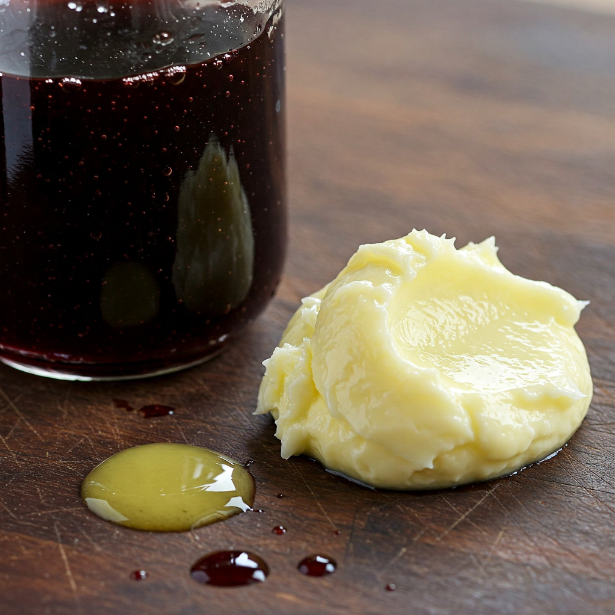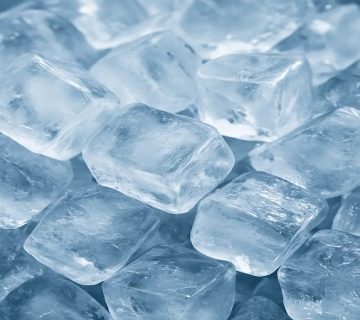In today’s world, there is a growing tendency toward consuming natural foods with medicinal properties. Grape molasses and ghee—two traditional Iranian products—have gained special attention in both traditional medicine and scientific research due to their numerous antioxidant and antimicrobial benefits.
In this article, we will explore the therapeutic properties of these two substances, analyzing them from both scientific and traditional perspectives.
What Is Grape Molasses?
Grape molasses, also known as "doushab," is a thick, sweet liquid made by boiling down grape juice. In traditional medicine, it is considered a natural energy source, a liver tonic, and a blood-enriching food.
Chemical Composition of Grape Molasses
Grape molasses is rich in the following:
Polyphenols (such as resveratrol and quercetin)
Vitamin C
B vitamins
Iron, magnesium, and potassium
Natural sugars (glucose and fructose)
Antioxidant Properties of Grape Molasses
Antioxidants are substances that prevent the oxidation and degradation of cells caused by free radicals.
Why Are Antioxidants Important?
Free radicals are responsible for premature aging, cancer, heart disease, and weakened immunity. Consuming antioxidant-rich foods like grape molasses plays a crucial role in preventing these conditions.
Key Health Benefits of Grape Molasses
Reduces cellular oxidative stress
Strengthens the immune system
Lowers cancer risk
Prevents cardiovascular diseases
Improves liver function and purifies the blood
Antimicrobial Properties of Grape Molasses
Studies have shown that the phenolic compounds in grape molasses have antibacterial and antifungal properties.
Effect on Bacteria
Grape molasses can inhibit the growth of harmful bacteria such as Escherichia coli and Staphylococcus aureus. This is particularly useful in treating wounds and preventing infections.
Traditional Use in Wound Treatment
In traditional Iranian medicine, applying warm grape molasses on wounds or blisters was recommended to prevent infection.
What Is Ghee?
Ghee is the result of processing animal butter (traditionally made), where water and milk solids are removed, leaving behind pure fat. This oil is widely used in traditional cooking in Iran, India, and some Arab countries.
Key Components of Ghee
Saturated and unsaturated fatty acids
Butyric acid
Vitamins A, D, E, and K
Natural cholesterol
Antioxidant Properties of Ghee
Ghee, especially due to its butyric acid content, has strong anti-inflammatory and antioxidant effects.
Health Benefits of Ghee
Reduces inflammation in the body
Supports digestive health
Protects cells from oxidative damage
Aids in the treatment of autoimmune diseases like colitis and Crohn's
Promotes skin health
Antimicrobial Properties of Ghee
Recent research shows that ghee can inhibit the growth of certain microorganisms, particularly bacteria.
Traditional Use in Immune Support
In many traditional medicine practices, ghee is used for body massage in infants or during recovery periods to strengthen the body and prevent infections.
Comparing Grape Molasses and Ghee in Terms of Health
| Feature | Grape Molasses | Ghee |
|---|---|---|
| Type of Active Compounds | Polyphenols, Vitamin C | Butyric acid, Vitamins A and D |
| Antioxidant Effect | High – cancer prevention, heart health | Moderate to high – anti-inflammatory |
| Antimicrobial Effect | Effective against bacteria and fungi | Effective against bacteria, immunity boost |
| Recommended Daily Intake | 1–2 tablespoons | 1 tablespoon or less |
| Traditional Medicine Use | Strongly recommended | Widely used in traditional remedies |
Combined Use in Diet
One delicious and effective way to enjoy the benefits of both ingredients is to combine them in breakfast or snacks. For example:
Grape molasses and ghee spread on bread for breakfast to boost immunity
Use in homemade cakes or desserts
A warm traditional drink made with both (like a Persian version of butter coffee)
Important Notes on Consumption
Grape molasses is high in natural sugars; people with diabetes should consume it with caution.
Ghee, due to its saturated fat content, should be used in moderation—especially for those with high cholesterol.
The best time to consume these products is in the morning on an empty stomach or with whole grain bread.
Conclusion
Grape molasses and ghee are two traditional foods that offer not only exceptional flavor but also remarkable health benefits. Their antioxidant and antimicrobial properties play a significant role in disease prevention, immune support, and overall well-being.
Including these ingredients in your daily diet, especially during the colder months, is a smart and health-oriented choice.
Furthermore, the production and distribution of these products in compliance with SFBB (Safe Food Better Business) standards and obtaining the SFBBCERT certification ensures their quality, safety, and health benefits for consumers.





No comment